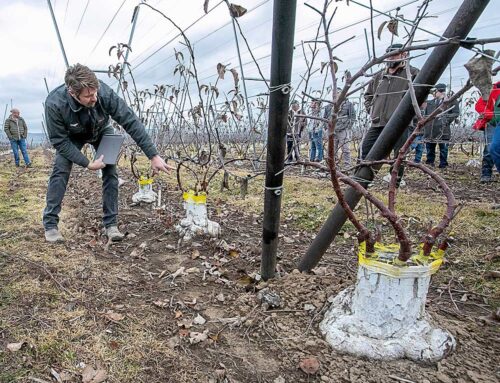
grower / Poplar Grove, Illinois
age / 29
crops / Apples, diversified farm
business / Manager of Edwards Apple Orchard
family background / Third-generation farmer of a 52-acre farm with market and u-pick operation. The market operates for three months starting at the end of August. Nephew of Edwards Orchard owner Ken Hall.
Why did you pursue farming?
I grew up on a dairy farm, which I absolutely loved. By the time I was 8 years old I started selling caramel apples at the farm market and progressed through several of the farm jobs.
When I went through high school, I wanted to do just about anything other than working at an orchard. I pursued my college degree in education, and at that time I realized how much I missed the farm. The sights, smells, and working with your hands outside—all those things along with growing fruit that makes so many people happy.
How do you operate a farm-to-table market?
We grow 17 different apple varieties. For us, that diversity helps us get through the season because we pick everything for fresh market, not cold storage.
The fruit is only available when it’s in peak production. Our thought is about providing the best possible taste to our customer. To get that, our u-pick and market customers are sold fruit that’s juicy and ready to eat. As soon as one variety is coming out of season, we pick it and put it right into our cider operation, then move our guests to the next variety.
What are the more popular varieties?
Our most popular is Honeycrisp, primarily grown on Budagovsky 9 rootstock. It’s a huge success for us. From there, Jonagold, Golden, and Red Delicious are especially popular with our pick-your-own operation.
We are also trying out some newer varieties like Evercrisp and Pixie Crunch and Liberty. We don’t know how well they’ll do for us just yet, but we are excited about the possibilities.
What are challenges unique to operating the farm market?
The workload during the season definitely comes in waves. Once the market opens we start off really fast and our mindset is focused on getting through that busy beginning. At that time, the family’s working extremely long hours, sometimes 17 hours each day, six to seven days a week.
One of the challenges during those times is handling staff morale. As a family business, it’s just as important that we get along with each other as it is to have a positive relationship with our customers during stressful times.
Why does operating a farm market make sense in your region?
Chicago is two hours away from us in one direction and Milwaukee and Madison about an hour and a half away from us. So we’re in the middle of this immense population.
These communities are accustomed to staying in the city, not getting out in the country much, so when they do, they go to destinations. Most of our customers come out for the day, they pick apples, they get a sense of an agricultural area and see where their fruit comes from.
What parts of the business do you focus on?
It comes down to two different parts, the horticultural and marketing.
A really big part of how we run our business is marketing. If you grow really great fruit and have great growing practices, but you can’t get it out the door, then the fruit is worthless. Something we do to market our quality is to provide samples to every customer who comes through the door. If the product tastes great, it will sell itself.
With the horticultural side, staying on top of growing systems and new varieties is really important because we want to find the best way to grow our orchard. Whatever we do must suit our business and all the people who visit our business. We are trying to stay ahead of what the next big variety is going to be.






Leave A Comment